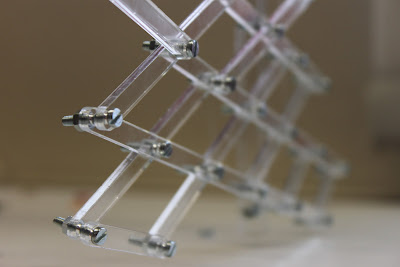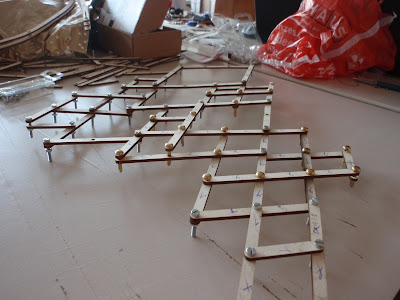Synthetic Ornament is an exploration in the realms of ornamentation, aesthetics, physical computing, prosthetics and fashion technology. It’s an attempt to understand the underlying logics of ornamentation, both in natural and in cultural systems, and to apply them in a prototypical project of an interactive piece of clothing, intended as a way to blur the borders between body and technological extensions.
The aim is to overcome superficial judgments on this theme and to explore the real implication of the renewed interest in ornament and in its theoretical concerns, especially in relation to the advent of the digital design techniques in the design world[1]. The aesthetics at the base of this thrive to complexity, articulation and interconnection of the parts, looking at the gothic and the baroque as seminal moments of coherent fusion between structure and ornament.
Final objective of the design phase is the creation of an “ornamental organism”, an interactive system with the scope of generating aesthetic pleasure in the observers, consciously refusing any other function and even partially inhibiting some functions of the user. As to say, beauty at any cost.
From Nature to Society
Ornament is a complex, contradictory and often misunderstood term: in biological terms, ornament is defined as “a structure of an animal that appears to serve a decorative function rather than an ostensible, utilitarian function.”[2]. This stresses the non-utilitarian function of this element, also if just in a superficial way. As Darwin showed[3], most of the ornamental strategies developed in the biological world are closely linked with sexual selection and reproduction, being mainly destined to attract mates.
But, beside this, the study of animal behavior show many interesting uses of ornamental devices: from communication between mates (cuttlefish), to diet responses (nudibranches), to seasonal changes and camouflage (many species of mammals and reptiles), to even “mood” communication (chameleon). All these clearly show as in nature is really rare to find any element that has a purely ornamental value, completely disconnected from any practical living necessity.
The concept of ornament assumes a totally different importance and meaning in the human society. According to Michael Weinstock, “personal ornaments are visual displays that convey information to outsiders, indicating the membership of a specific group, and more personal information such as married status or adulthood”[4]. Indeed, in human culture ornamentation becomes a central point when it comes to define the identity of a person or of a social group, and in this way these forms without function assume many complex and interrelated values.
More than this, the ornament become, as soon as the human developed an aesthetic sensibility, one of the centers of generation of the aesthetic experience. Considering the aesthetic dimension as “a moment in which the form production of morphogenetic systems generate patterns that interfere with cultural systems, shaping and influencing them, and getting themselves influenced by these”[5], the ornament shows a clear productive capacity and a complex and interactive behavior, that links together form generation, culture development and social values.
From ‘Purism’ to ‘Exuberance’
In architecture, the ornament always assumed a high relevance, especially in periods like the gothic and the baroque, and it has been the preferred vector for the diffusion of moral and ethical values to the masses. The modern movement “purification of form” pushed the ornament aside for almost a century, but in the last years the advent of the digital tool and the increases in complexity and articulation allowed by these brought ornamentation issues back in the center of the architectural discourse.
“The system seemed to open up, to become more inclusive; more interpolated, inquisitive, impatient; more Baroque, even Rococo (Rococo being the feminine moment of the Baroque). And more excessive, extravagant, exuberant. Thus Exuberance turned into a manifesto. Of the pervasiveness of phenomenological aspects of digitality, of the varied approaches towards digital design, of the non-engineered intelligence of digital space, of the profuseness of digibio-techno ornamentation, of the abundance of CGI in Hollywood, of the excessiveness of computer games, of the lavishness of Middle Eastern and Asian super-urbanism. But also of fluidity and elegance, of a rather sinister neo-Jugendstil revival, even of a neo-Rococo ‘prettynisation’ of the digital”[6].
This strong and sudden return of the ornamentation into the architectural theory and practice requires some classification and thoughts, since handling this topic requires knowledge in different fields, from fashion to digital design, from aesthetics to technology. Marjan Colletti coined two main terms to define the most evident tendencies in ornament approaches today: ‘ornaMental’ and ‘pOrnamentation’: “”The first propels towards 'pure form' through abstraction, the latter towards the 'purely figural' through sensation.”[7]. This broad distinction gives a interesting toolset to explore the implications of ornament in architecture, and defines two divergent tendencies which somehow need to get rejoined in order to give a new strength and value to the ornamentation in architecture.
Interactive Fashion and Synthetic Ornament
In order to explore the complex field of integration that ornamental devices can generate, the project focused the attention on a small scale prototype, anyway able to give clues about this topic. In order to center the attention on the concept of ornament as “form without function”, the field of fashion design seemed to be one of the most adapt.
Considering clothing at the same time as “the first form of architecture” and as “a prosthetic extension of human body and metabolism”, the creation of a fashion piece becomes a real architectural action, exploring the field of human relationships, once defining a barrier to this interaction and once creating an attractor of aesthetic values. More than this, it allows to almost abandon any functionalism in order to create a piece of “pure ornamentation”, a parasitic system whose food is the vanity of the user, and whose effect is the interdiction of any possible intimate connection between the user and any observer. It’s “ornament for ornament’s sake”.
Interactive Prototype
The initial research looked into the ornamental possibilities of simple geometrical patterns, considered a good starting point for their deformational abilities, necessary in the construction of a system able to show mutation and morphing in response to external stimuli.
The search lead to the construction of a quad pattern with modular elements of different sizes, linked togheter with simple bolt-screw connections.
The next step has been the definition and programming of the electronic system necessary to control the prototype and make it reactive to external influences. After some tests, we choose to use the LilyPad Arduino microcontroller, mainly for its lightness, flexiblity and for the possibility of powerinf the system via small ion batteries.
The interactive layer of the system is composed by two elements:
- the sensing device is a Matibox EZ0 ultrasonic range finder, used to detect the presence of people near the wearer and to calculate the distance of these from the sensing point.
- the actuators are two simple Modelcraft micro servos (that in the end appeared as too weak for moving the whole system).
These simple devices have been connected togheter through the LilyPad board, allowing to link directly the distance readings of the EZ0 with the movement of the motors (and consequently the contraction and expansion of the ornamental pattern).
All these elements and ideas have then been combined in the final prototype, built with lasecut plexiglass components, with the aim of creating a clean and elegant design.
Video of the final prototype in action (thx to Christine for being the model):
Built with Lilypad Arduino Simple Board, Modelcraft micro servos and MaxBotix EZ0 ultrasonic range finder.
Programmed in Arduino by Andrea Rossi
CAD/logic course - prof. Liss C. Werner - Dessau Institute of Architecture
Synthetic Ornament team : Christine Baldwin, Hazel Cruz, Andrea Rossi
[1] Cf. ‘AD Exhuberance’, March/April 2010. Wiley and Sons
[2] http://en.wikipedia.org/wiki/Biological_ornament
[3] Darwin, Charles (1871) ‘The Descent of Man’, Prometheus Books
[4] Weinstock, Michael (2010) ‘The Architecture of Emergence’, Wiley
[5] Erioli, Alessio (2011) ‘Fashion Robot’ studio brief, web publication
[6] Colletti, Marjan (2010) ‘Introduction to AD Exuberance’, March/April 2010. Wiley and Sons
[7] Colletti, Marjan (2010) ‘ornaMental pOrnamentation. The Abstract an the Exuberant Body of Ornamentation’, web publication












No comments:
Post a Comment